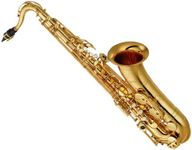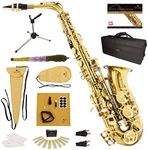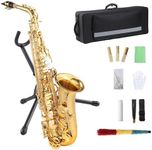Buying Guide for the Best Tenor Saxophones
Choosing the right tenor saxophone can be a rewarding experience, but it requires some understanding of the key features and specifications that differentiate one model from another. Whether you are a beginner, intermediate, or advanced player, knowing what to look for will help you make an informed decision and find the best fit for your needs. Here are some important specifications to consider when selecting a tenor saxophone.MaterialThe material of a tenor saxophone affects its durability, weight, and sound quality. Most saxophones are made from brass, but the finish can vary, including lacquer, silver plating, or gold plating. Lacquered brass is common and offers a warm sound, while silver plating can provide a brighter tone. Gold plating is often used for its aesthetic appeal and can slightly enhance the richness of the sound. Choose a material based on the sound you prefer and the level of maintenance you are willing to commit to.
Key MechanismThe key mechanism refers to the design and layout of the keys on the saxophone. A well-designed key mechanism ensures smooth and comfortable playability. For beginners, a simpler key mechanism with fewer adjustments is ideal, while advanced players might prefer a more complex mechanism that allows for greater control and customization. Test the key action to ensure it feels comfortable and responsive to your touch.
Bore SizeThe bore size of a tenor saxophone affects the instrument's resistance and the ease of producing sound. A larger bore typically offers a fuller, more robust sound but may require more air support, making it suitable for experienced players. A smaller bore is easier to play and control, making it a good choice for beginners. Consider your playing level and the type of sound you want to achieve when selecting the bore size.
MouthpieceThe mouthpiece is a crucial component that greatly influences the saxophone's sound and playability. Mouthpieces come in various shapes, sizes, and materials, each affecting the tone and ease of play. Beginners should start with a standard mouthpiece that offers a balanced tone and is easy to play. Intermediate and advanced players might experiment with different mouthpieces to find one that complements their playing style and desired sound.
Neck DesignThe neck design of a tenor saxophone can impact the instrument's intonation and response. Some necks are designed to offer better tuning stability and ease of play, while others might enhance the tonal quality. Beginners should look for a neck that provides good intonation and is easy to play, while advanced players might seek out specific designs that match their playing style and sound preferences.
Weight and ErgonomicsThe weight and ergonomics of a tenor saxophone are important for comfort and playability, especially during long practice sessions or performances. Heavier saxophones can produce a richer sound but may be more challenging to handle, particularly for younger or smaller players. Look for a saxophone that feels comfortable to hold and play, with well-placed keys that suit your hand size and playing posture.
Brand ReputationThe reputation of the brand can be an indicator of the quality and reliability of the saxophone. Established brands with a history of producing high-quality instruments are often a safer choice, especially for beginners who may not have the experience to evaluate the finer details of a saxophone. Research different brands, read reviews, and consider recommendations from teachers or experienced players to help guide your decision.





















